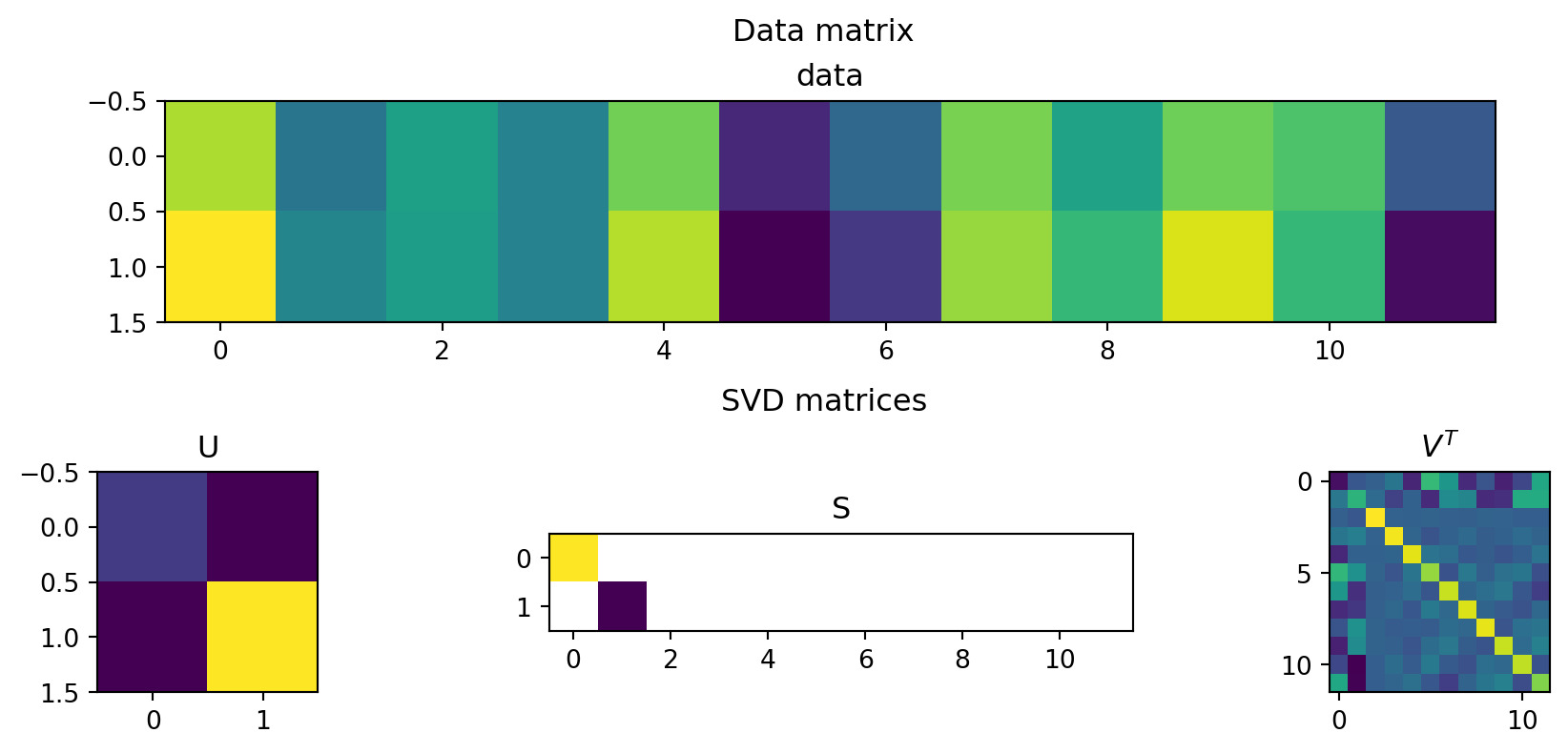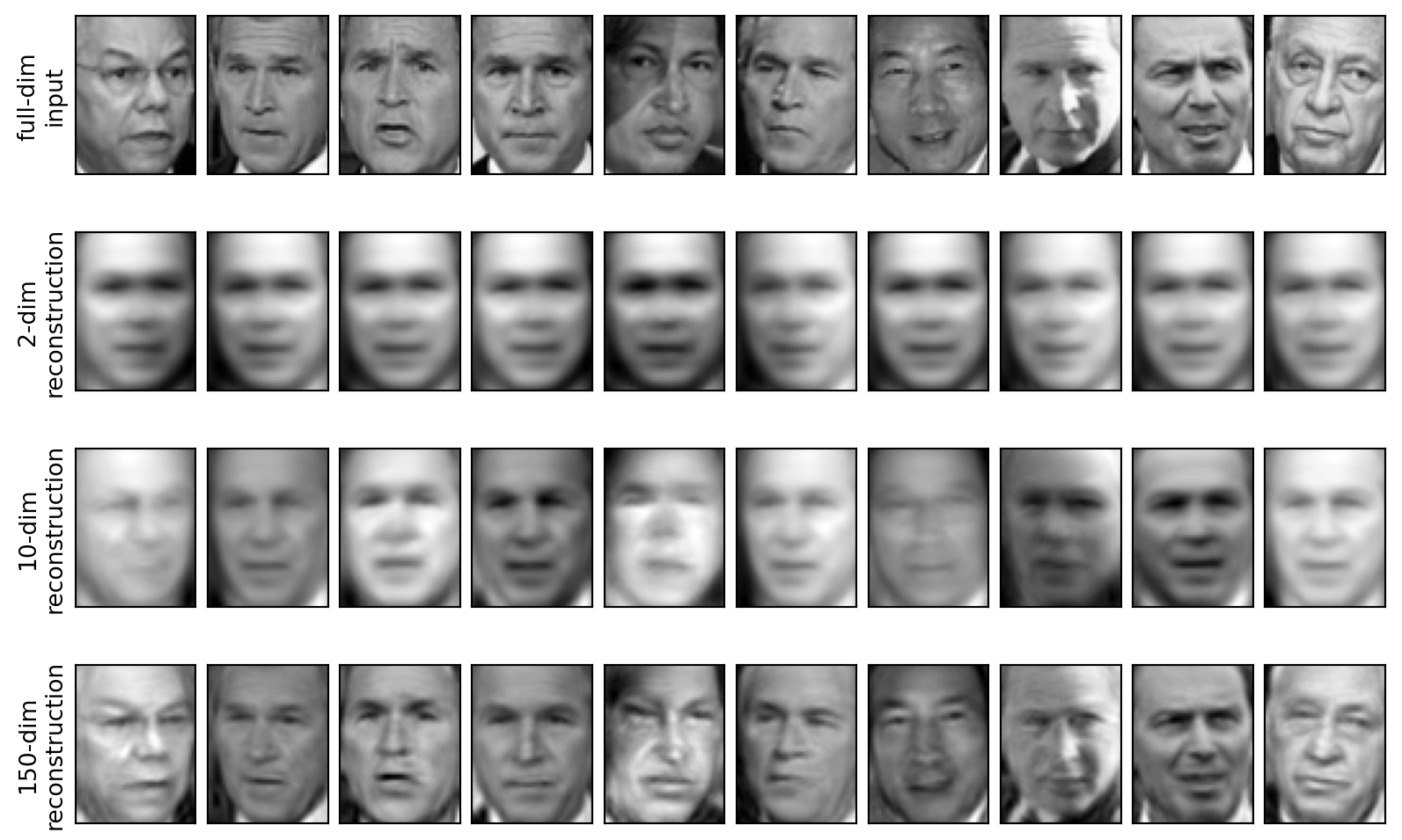<Figure size 960x480 with 0 Axes>Ch5 Lecture 4
SVD on matrices of data
Example: Height and weight
\(A^T=\left[\begin{array}{rrrrrrrrrrrr}2.9 & -1.5 & 0.1 & -1.0 & 2.1 & -4.0 & -2.0 & 2.2 & 0.2 & 2.0 & 1.5 & -2.5 \\ 4.0 & -0.9 & 0.0 & -1.0 & 3.0 & -5.0 & -3.5 & 2.6 & 1.0 & 3.5 & 1.0 & -4.7\end{array}\right]\)
\(A^T=\left[\begin{array}{rrrrrrrrrrrr}2.9 & -1.5 & 0.1 & -1.0 & 2.1 & -4.0 & -2.0 & 2.2 & 0.2 & 2.0 & 1.5 & -2.5 \\ 4.0 & -0.9 & 0.0 & -1.0 & 3.0 & -5.0 & -3.5 & 2.6 & 1.0 & 3.5 & 1.0 & -4.7\end{array}\right]\)
Plotting
The columns of the U matrix, graphically:
U captures relationships between the rows of the data matrix.
Since there are only two rows, only 2x2 matrix needed to capture all the relationships.
The first two rows of the \(V^T\) matrix
V captures relationships between the columns of the data matrix. 12x12 possible values, but only 12x2 needed to capture all the relationships.
The data from these first two rows of the \(V^T\) matrix, after multiplication by the singular values and rotated by the columns of the U matrix:
A reminder:
\[ \mathbf A = \mathbf{USV^\mathsf{T}} = \sigma_1 u_1 v_1^\mathsf{T} + \dots + \sigma_r u_r v_r^\mathsf{T} \]
SVD on images
Motivation: a cat
Dimensions of the decomposition
What are the dimensions of the decompositions for an image?
Code
The shape of U is (360, 360), the shape of S is (360,), the shape of V is (360, 360)pause
Left singular values, corresponding to U, are the eigenvalues of \(AA^T\). For an image, \(AA^T\) is the covariance matrix of the rows of \(A\).
Right singular values are the eigenvalues of \(A^{T}A\). For an image, \(A^TA\) is the covariance matrix of the columns of \(A\).
Simple example
Reconstructing our matrix
How much of the variance is captured by the first two components?
The variance captured by the each component is the sum of the squares of the singular values divided by the sum of the squares of all the singular values.
Back to the cat
First Singular Value
Second Singular Value
Third Singular Value
Adding them up
Color images
Code
# SVD for each channel
U_R, S_R, Vt_R = np.linalg.svd(R, full_matrices=False)
U_G, S_G, Vt_G = np.linalg.svd(G, full_matrices=False)
U_B, S_B, Vt_B = np.linalg.svd(B, full_matrices=False)
n = 50 # rank approximation parameter
R_compressed = np.matrix(U_R[:, :n]) * np.diag(S_R[:n]) * np.matrix(Vt_R[:n, :])
G_compressed = np.matrix(U_G[:, :n]) * np.diag(S_G[:n]) * np.matrix(Vt_G[:n, :])
B_compressed = np.matrix(U_B[:, :n]) * np.diag(S_B[:n]) * np.matrix(Vt_B[:n, :])
# Combining the compressed channels
compressed_image = cv2.merge([np.clip(R_compressed, 1, 255), np.clip(G_compressed, 1, 255), np.clip(B_compressed, 1, 255)])
compressed_image = compressed_image.astype(np.uint8)
plt.imshow(compressed_image)
plt.title('n = %s' % n)
plt.show()
# Plotting the compressed RGB channels
plt.subplot(1, 3, 1)
plt.imshow(R_compressed, cmap='Reds_r')
plt.subplot(1, 3, 2)
plt.imshow(B_compressed, cmap='Blues_r')
plt.subplot(1, 3, 3)
plt.imshow(G_compressed, cmap='Greens_r')
plt.show()How many singular values to keep?
Different sorts of images
Just plain noise:
pause
Plaid shirt
pause
Singular values
Individual components
First component:
Second component:
Using “PCA” from sklearn
This is just an easier way to implement taking these first few components…
Code
from sklearn.decomposition import PCA
pca = PCA(n_components=2)
pca.fit(R) # fit the model -- compute the matrices
transformed = pca.transform(R) # transform the data
print(f'The shape of the image is {R.shape}, and the shape of the compressed image is {transformed.shape}')
plt.imshow(transformed.T)The shape of the image is (168, 299), and the shape of the compressed image is (168, 2)Try adding noise…
Now clean it up with PCA:
SVD in higher dimensions
Faces
Code
from sklearn.datasets import fetch_lfw_people
faces = fetch_lfw_people(min_faces_per_person=60)
# display a few of the faces, along with their names
fig, ax = plt.subplots(3, 4)
for i, axi in enumerate(ax.flat):
axi.imshow(faces.images[i], cmap='bone')
axi.set(xticks=[], yticks=[],
xlabel=faces.target_names[faces.target[i]])
print(f'The shape of the faces dataset is {faces.images.shape}')The shape of the faces dataset is (1348, 62, 47)pause
PCA on faces
Code
PCA(n_components=2, random_state=42, svd_solver='randomized')In a Jupyter environment, please rerun this cell to show the HTML representation or trust the notebook.
On GitHub, the HTML representation is unable to render, please try loading this page with nbviewer.org.
PCA(n_components=2, random_state=42, svd_solver='randomized')
Reconstructions
Really cool demo of SVD image compression: https://timbaumann.info/svd-image-compression-demo/
Now you
Code up your own image compression using SVD and show the left and right singular vectors, the singular values, and the reconstructed images.
Share with the class!



































